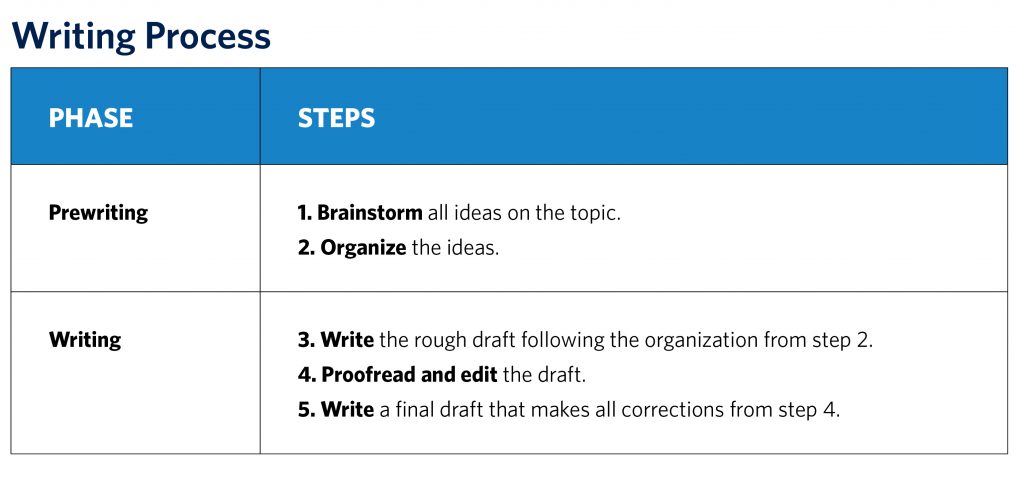Process Writing
Process writing is a way of breaking down the task of writing into its smaller component parts. By completing each step sequentially, writing becomes a less threatening and less daunting task. Students learn that writing doesn’t just happen; it is planned and it evolves, taking shape as it develops. The steps in process writing can be divided into two major phases: the prewriting phase and the writing phase. Both are necessary to the writing process and are interdependent. Prewriting is needed to organize, sequence, and elaborate on ideas prior to writing. The writing phase turns this organization of ideas into a composition.

The Prewriting Phase
The prewriting phase is essential to helping students generate and organize their thoughts prior to writing. It establishes the roadmap of the writing piece, allowing them to see where they are going with their ideas and how they will get there. Writing without working through the steps of the prewriting phase is like sending a student to an unknown destination without a map or directions. They will most likely veer off course, perhaps go in circles, and get lost. Students may even forget where they were going in the first place. With no direction in which to go, they may be unable to start at all. Similarly, without generating and organizing ideas first, your students’ writing often loses direction. Although they may start with a solid idea for a composition, without a “road map,” writing often strays from the topic, fading out or winding up at a different destination than originally intended.
There are two steps in the prewriting phase:
- Select a topic and brainstorm by jotting down all ideas on the topic as they come to mind.
- Organize the ideas by putting them into categories of main ideas and corresponding details. This organization can take various forms, depending on your student’s style or preference (outline, notes, graphic organizer, semantic map).
Many students benefit from oral discussion of concepts before they put their ideas into writing. In addition, seeing all their ideas on paper often helps them see how material might be grouped together or recognize the connections between ideas.
The Writing Phase
Once the prewriting phase has been completed and a method for organizing ideas is ready, the most difficult part of the process is over. Your students merely need to follow the structure they have created to write the paragraph, composition, or essay without worrying about the topic, supports, and direction of their writing.
The steps in the writing phase are:
- Write the rough draft, adhering to the organization created in the prewriting phase and turning each note into a sentence, adding transitional words or phrases to connect ideas, etc.
- Proofread and edit the rough draft for both content and mechanics.
- Write a second draft (and possibly more) including all corrections and changes made.
During the writing phase, it is important that your students apply their knowledge of specific composition skills in order to turn their ideas from the “roadmap” (outline / notes / graphic organizer / semantic map) into full sentences which connect and form cohesive, unified paragraphs. Paragraph templates may be helpful for some students as a visual reminder to implement all components of a paragraph. Students may also find it helpful to have a list of transitional words and phrases to choose from.
During the proofreading step, encourage your students to read their compositions out loud to someone, or have someone read their writing to them. This often makes it easier to identify errors. When we read our own writing to ourselves, we often read it the way we intended it to be, not the way it is actually written on the page. In addition, individualized proofreading checklists are often helpful to guide students in the proofreading process. These checklists could include specific skills which your students are currently studying and should have the writer interact with his/her writing in some way (circle all the capital letters, highlight the topic sentence, underline transitional words and phrases, etc.). As your students become more aware of their own writing skills, they should be encouraged to develop their own proofreading goals.
Finally, depending on the purpose and length of the writing, more than one draft may be written before a final draft is produced. A single paragraph may only require one rough draft with revisions, followed by a final draft. A longer composition, however, may require several drafts before a final, more polished product is created.
Attached is a document that contains a graphic organizer, template, and proofreading checklist for students to use when constructing a well-written single paragraph.
Note: If your student needs to write a multi-paragraph composition, he/she can still use these formats for each paragraph, then put them together.



